Tiger lily: description, varieties, planting and care

Lily is a truly beautiful flower that almost every woman loves. A special place among the Liliaceae family is occupied by the species "tiger lily" bred in East Asia. It is quite unpretentious in care, is not afraid of Siberian frosts and, among other things, has high decorative qualities. We will talk in more detail about the garden tiger lily and its varieties in the article.
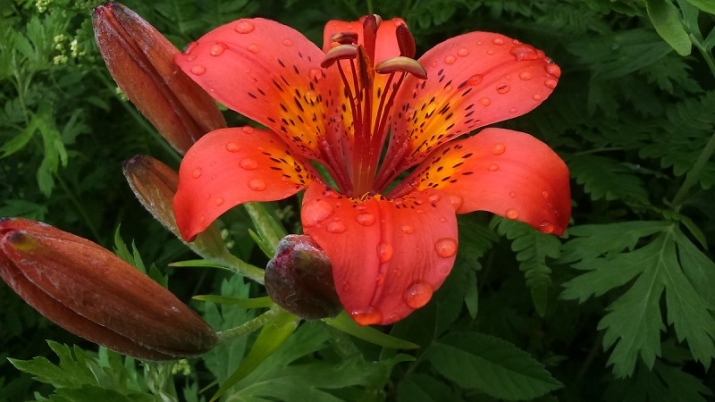





Description
The homeland of the Lanceleaf Lily variety (Lilium Lancifolium) is Japan and China. Gardeners began to cultivate this variety relatively recently - due to problems with poor survival rate, the wild-growing flower bloomed only in the 19th century. Thanks to intensive breeding work, scientists have managed to breed several hybrid varieties with an unpretentious character.
The so-called bulbous perennial - lily - reaches 2 meters in height. "Tiger" stems are stiff, moreover, they are tomentose-pubescent. The color is closer to purple. The bulb is white, large in size, has a spherical shape.
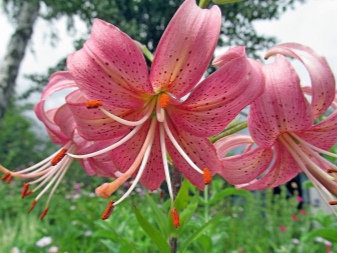
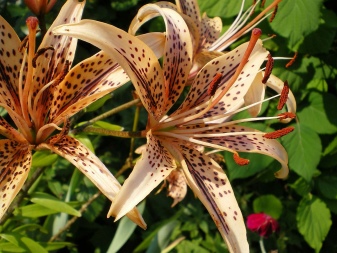
The lily family is distinguished by its root system, which consists of three types: bulbous basal, bulbous retractors and supra-luminous nourishing. The third type is formed above the bulb on the stem, looks like thin threads, performs the function of feeding and maintaining the stem in an upright position. The deciduous system is well developed - the leaves reach 15 cm in length, sessile, narrow, lanceolate, located on the stem alternately, painted mainly in dark green. In addition, the upper pair of leaves is much shorter, small bulbs are formed in their axils, intended for further propagation of the flower.
By the way, these so-called buds distinguish the tiger lily from its other brethren. Unfortunately, hybrid varieties lose this feature over time.
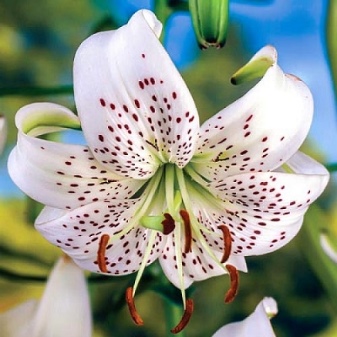
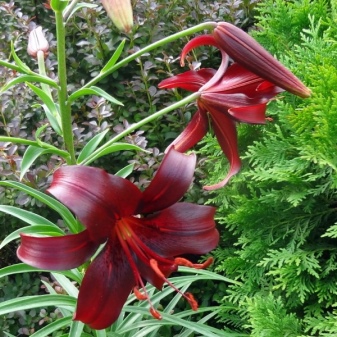
The lily inflorescences are lanceolate in structure, loose, racemose. They consist of large flowers (the number varies from 3 to 10), outwardly resembling bells. The length of the flowers is 10-12 cm, the pedicels are pubescent, the smell is weak. Blooming lilies have different colors - it all depends on the specific variety. In addition, the color on the buds lasts no more than a week.
So, wild lily has an orange color with noticeable spots on the inside of the bud... The flowering period is from July to September. The fruit is a capsule with many flat seeds. Interestingly, the first flowering occurs 3 years after the bulb is planted.
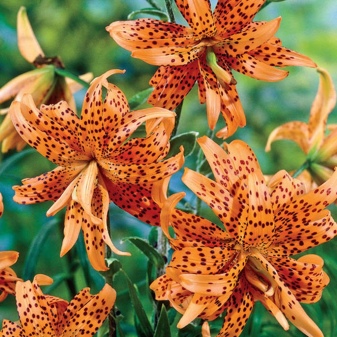

Varietal variety
Consider the most famous garden forms of the tiger lily.
- "Splendens" (L. Splendens) - this variety is characterized by bright orange buds, decorated with small dark spots. One stem can hold about 20 flowers. Lily "Slendens" grows up to 1 meter. This variety is quite hardy, successfully takes root in open and shaded areas.
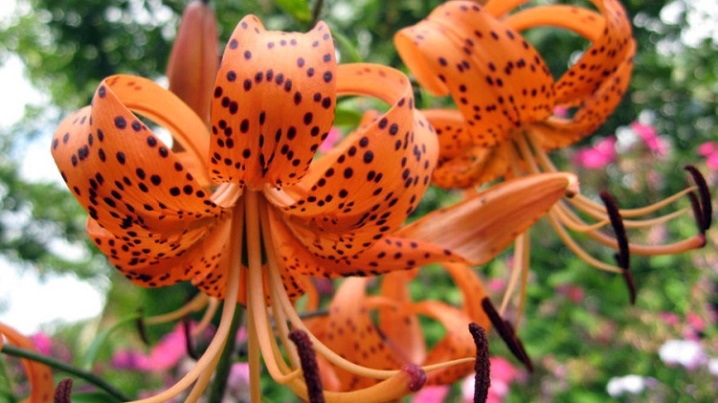
- "Fluffy Leopard" (L. Pardalinum) - the first terry lily variety. The buds are painted in a rich orange color with familiar dark freckles, for which it got its name. Each flower has 30 petals. About 20 buds are kept on one peduncle. "Leopard" is especially picky about sunny location, otherwise similar to other forms.

- L. Pink Tiger - there are pink or orange-red specimens with characteristic dark blotches. The bud is quite large - 10 cm. The plant itself reaches 1.2 meters in height. Gardeners consider the "pink" lily one of the most beautiful, but it is most susceptible to various diseases.

- L. Night Flyer - differs in burgundy-red flowers, there are few blotches. The diameter of the bud reaches 16 cm, the height of the stem is 120 cm. The hybrid of the tiger lily reproduces well, and also develops successfully in cold conditions.
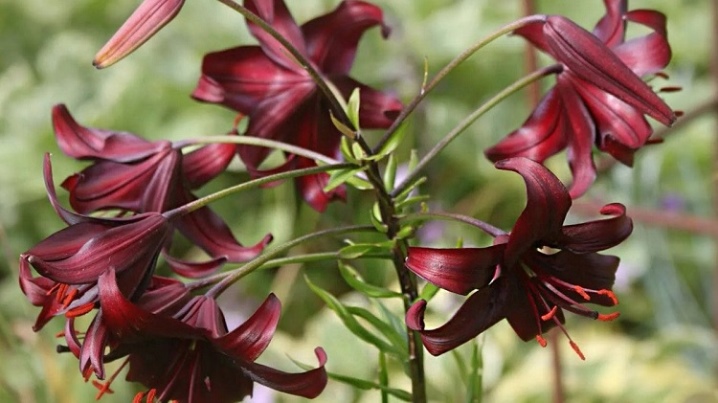
- "Flora Plena" (L. Flora Plena) - terry variety, frost-resistant. It is characterized by bright red flowers with black dots. Blooming buds (12 cm in diameter) consist of 40 petals that fold back when opened. The stems are not very high - only 90 cm. The hardy lily is especially fond of residents of cold regions, as it can withstand temperatures up to minus 35 degrees.
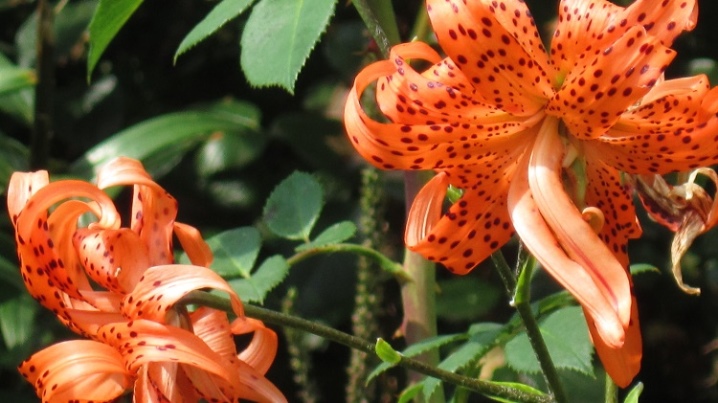
- L. White Tiger - a kind of tiger lily with drooping flowers. Differs in snow-white buds, dotted with cherry dots. The white variety also has rich flower stalks. The root system is considered fully developed in the third year of the bulb's life. Blooms closer to July.
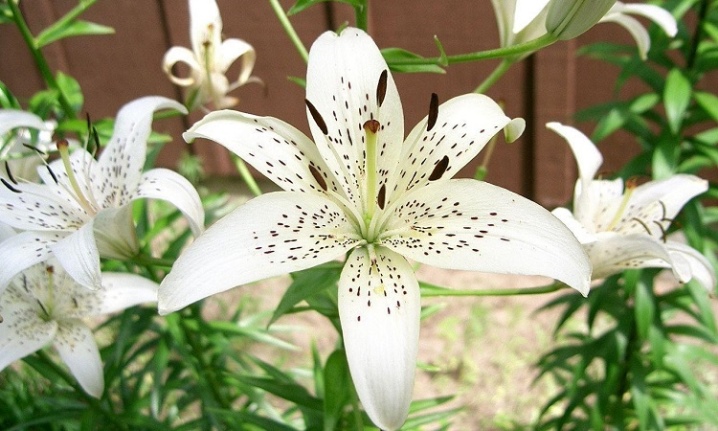
- "Citronella" (L. Citronella) - a variety with small flowers (up to 12 cm in diameter), a low stem. Has a rich yellow color, black spots. Flowering lasts only 25 days.
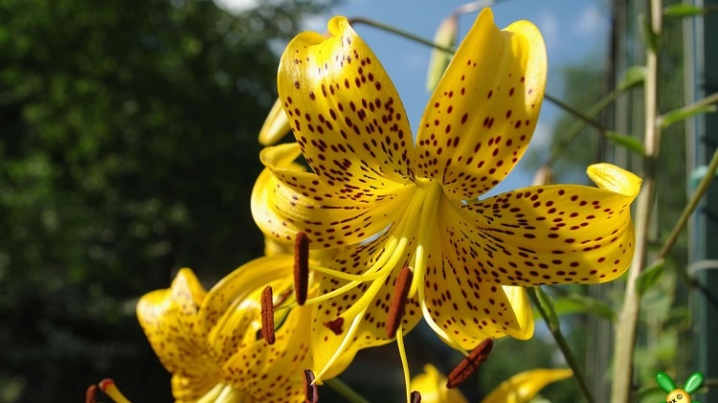
How to plant?
Tiger lily is an unpretentious type of garden plant. However, only if all agrotechnical conditions are observed, you can observe the beautiful flowering of this culture. First of all, you need to choose a favorable place for planting the bulbs. The plant loves the sun, although partial shade is also suitable, near trees. For full development and further flowering, a sufficient amount of light is needed.
There are no specific guidelines for soil type. The only thing is that the earth must be moisture-permeable, since lilies do not tolerate stagnant water. High humidity has a detrimental effect on the root system. Light fertile soil can extend the flowering period, as well as make the flowers brighter.
According to gardeners, an elevation will be a suitable place for planting a plant, since a short-term drought is not as dangerous as flooding.


In the northern regions, they begin to plant tiger lilies in the spring, in the southern ones - closer to September, but they have been preparing the soil since the previous fall. For successful rooting, you should choose a soil with low or neutral acidity. If the soil is acidic, ash is added before planting. If the ground is heavy, digging will be required with the addition of sand. Light soil only needs deep loosening (up to about 30 cm).
It is recommended to thoroughly fertilize the earthen hole before planting. For these purposes, humus (a bucket per 1 sq. M), potassium salt (50 g), superphosphates (100 g per 1 sq. M) are perfect. Instead of the above substances, gardeners are advised to use mineral complexes - potassium-phosphorus. You will also need drainage - for example, from sand.


So, first, holes are dug with a depth of 20 cm.In addition, it is important to observe the interval between them - not less than 15-20 cm. A drainage layer is laid on the bottom - preferably from river sand. Further, one onion is placed in each hole, lightly covered with soil, and at the end it is watered abundantly.
In the early years, young plants need shelter for the winter. For these purposes, a layer of mulch, spruce branches are perfect; in a winter with little snow, it will not be superfluous to additionally sprinkle the plants with snow.


How to take care of it properly?
Caring for a garden lily is not difficult. It is quite unpretentious, therefore, requires a minimum of costs. First of all, it is necessary to replenish the lack of moisture in the soil for the full development of the root and deciduous system. The main thing is to prevent stagnation of water, as this is fraught with rotting of the plant.Most often, the lily should be watered during the budding and flowering period. At the end of these processes, watering stops - just at this time, the bulbs are preparing for the approaching cold weather.
It is not worth feeding the flower too often - 3 times a year is enough. Spring feeding begins with nitrogen fertilizers. Further - in the summer (July), and then after flowering, closer to winter - at this time, phosphorus-potassium agents are especially useful.


Reproduction methods
Lanceolate lilies reproduce in several ways. However, experienced gardeners prefer the most efficient breeding paths for tiger varieties. Let's consider each of them in more detail.
- Bulbs. The landing is planned either in the spring or in August-September. The main thing is to have time before the first frost so that the plant takes root. Before planting the bulbs, a drainage layer consisting of compost and sand is laid on the bottom of the pit. The onion must be deepened by about 15 cm, watered abundantly. Experienced gardeners recommend first soaking the bulbs in a weak solution of potassium permanganate - 30 minutes is enough.
- Scales. Usually carried out when a plant is transplanted. To do this, scales are separated from large bulbs in order to plant them in moistened soil to a depth of 2-3 cm.It is important to create suitable greenhouse conditions so that in a couple of months the first sprouts will look out of the ground. For the duration of wintering, it is better to transfer the plant to a cool, dark place, and with the onset of spring it is safe to transplant it into open ground. Reproduction by scales guarantees the appearance of flowers after a couple of years.
- Buds. This process can occur in two ways: first, the seeds are scattered on their own to the ground, where young stems then grow. They, in turn, need to be transplanted to a permanent place. The second - in August, planting material is collected for further sowing in a wide container with prepared soil. During the fall and winter, the lily takes root, and in the spring it is planted in open ground. It is worth knowing that reproduction by bunch of bulbs, namely uncontrolled self-sowing, threatens with excessive thickening of the plantings.
- Seeds. The easiest way, moreover, does not thicken. True, seed germination is quite low - only 70%.

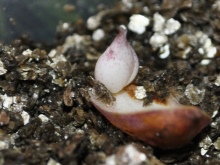

Diseases and pests
By nature, this horticultural crop is the carrier of the so-called mosaic virus. It is characterized by atypical spots on the leaves. It is interesting that this disease is not dangerous for this species itself, but garden crops growing nearby may suffer. Therefore, it is recommended to plant lilies separately. If the crop grows in alkaline soils, there is a risk of developing chlorosis. As a preventive measure, the soil should be fertilized with peat, and also covered with sawdust or needles. In addition, the flower is threatened with a disease such as gray rot. Therefore, before planting the bulbs in open ground, they must be treated with a foundation.
In the fight against another ailment - rust - fertilizers containing phosphorus and potassium are most effective.
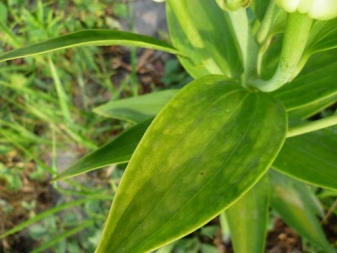
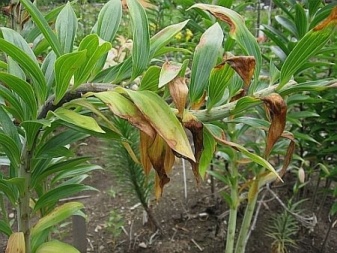
Examples in landscape design
Lanceolate lily can become a real decoration of any garden or summer cottage. So, in order to create the most beautiful composition, it is important to take into account the following factors: the color of the variety, illumination, and the presence or absence of neighboring plants. A garden lily looks more advantageous under the rays of the sun, however, in partial shade, an equally beautiful composition will turn out.
Designers use several compositional positions with the main character - a tiger lily:
- in the center of the flower bed there is a lily surrounded by annual and perennial ornamental plants;
- as a hedge along the path - several colors are used;
- occupies the background of a mixborder, for example, near a fence or fence;
- single landing.
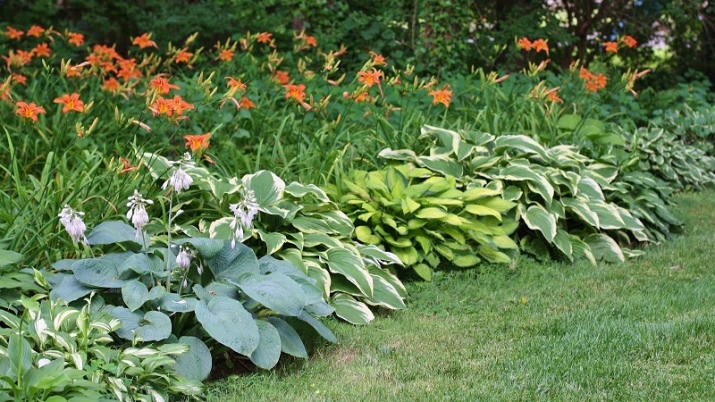





An incredible combination of colors can be created in the garden. To do this, orange lily buds are combined with dark yellow marigolds, red salvias, blue or purple petunias, scarlet pelargoniums. The texture of the foliage is also taken into account - in addition to the "tiger" culture, you can use phlox, western thuja, fern, juniper, eastern biota.
In any case, the blooming tiger lily will become a living decoration of the garden. The main thing is to prepare in advance for planting the bulbs and to provide further care for the young plant.
For information on how and when to transplant lilies, see the next video.







































































































The comment was sent successfully.